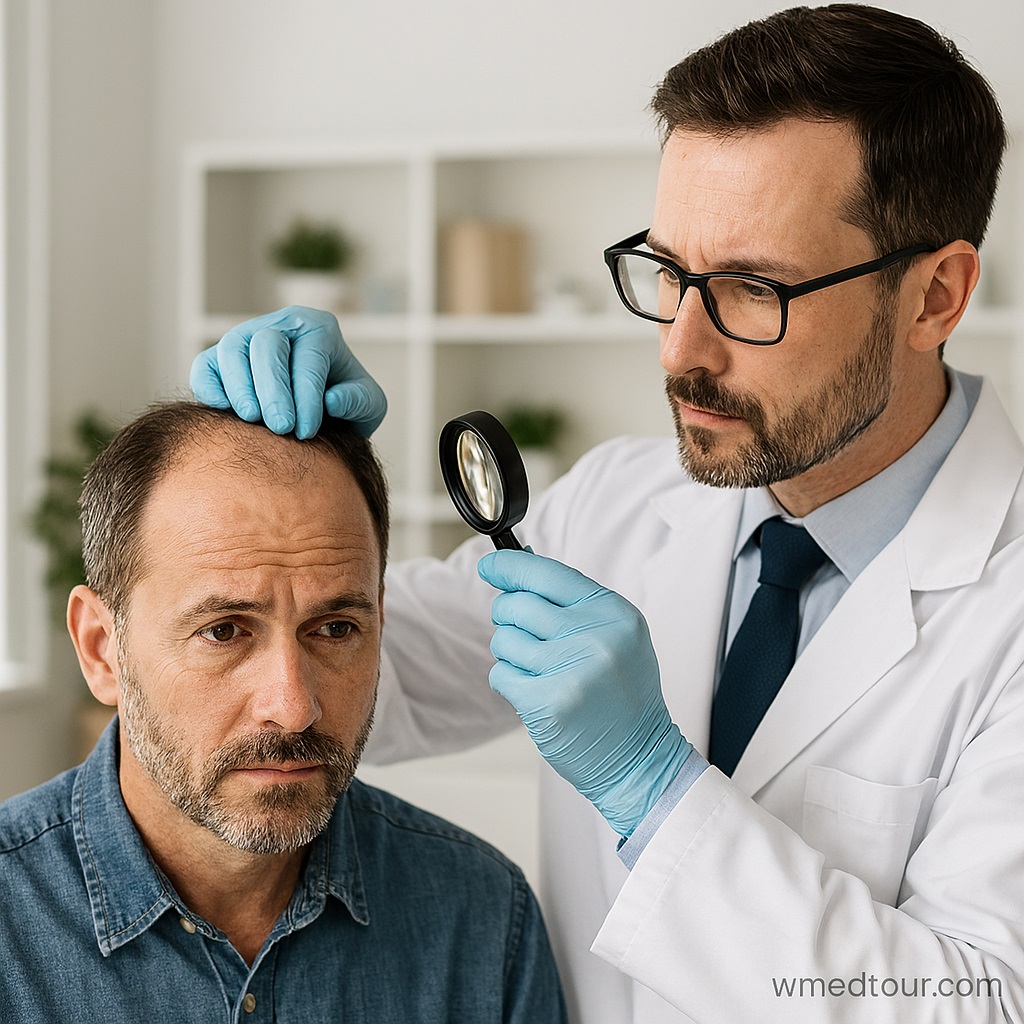Am I a Good Candidate for a Hair Transplant? (The Definitive Checklist)
Deciding on a hair transplant can feel overwhelming. You’ve probably wondered, “Am I even the right candidate?” This guide walks you through every factor you need to evaluate—health, hair status, expectations and more—so you feel confident at your consultation.
Understanding Hair Transplant Candidacy
What Is a Hair Transplant?
A hair transplant relocates healthy follicles from a donor area (usually the back of the head) to thinning or balding spots. Modern techniques like FUE (follicular unit extraction) and FUT (follicular unit transplant) deliver natural results with minimal downtime.
According to the International Society of Hair Restoration Surgery, millions opt for transplants each year because of reliably high success rates and long-term satisfaction.
Whether you’re local or considering medical tourism, knowing your candidacy is step one.
Why Candidacy Matters
Not everyone earns ideal results. A thorough candidacy evaluation reduces wasted time, cost, and disappointment. Surgeons assess your hair loss pattern, donor density, health history and even lifestyle habits to predict success.
Learn what to expect at your first consultation and how honest answers ensure you’re set up for the best outcome.
Key Factors to Consider Before a Hair Transplant
Age and General Health
Most candidates fall between 25 and 65 years old. Younger patients may still experience progressive loss, while older adults often have stable patterns. Your overall health—cardiac fitness, blood sugar control and smoking status—directly impacts healing and graft survival.
Review guidelines from the FDA and consult your physician before proceeding.
Degree and Pattern of Hair Loss
Stable, predictable loss (Norwood scale II–V) yields the best long-term coverage. Diffuse thinning or active autoimmune conditions require extra caution. For details on hair loss types, visit our Hair Loss Types Explained page.
Donor Area Quality
A dense, elastic donor zone—typically the scalp’s back and sides—is essential. Scar tissue, tight scalp skin or inadequate density limit graft availability. Surgeons often conduct a mini biopsy to measure follicle counts before the procedure.
Medical Conditions & Medications
Bleeding disorders, uncontrolled diabetes and certain immunosuppressants can hinder graft take. Disclose all medications, even over-the-counter NSAIDs. The CDC and Mayo Clinic offer comprehensive pre-surgical checklists to ensure safety.
Realistic Expectations & Mindset
Success isn’t measured in density alone. Natural hairline design, proper spacing and realistic outcome goals keep you satisfied. Review our Natural Look Guarantee for examples of what’s achievable.
Checklist: Are You a Good Candidate?
- Stable hair loss for at least 12 months
- Healthy donor area with sufficient density
- Non-smoker or willing to quit before surgery
- Realistic about timelines and outcomes
- No uncontrolled chronic diseases
- Strong support system for aftercare
- Able to follow pre- and post-op instructions
Comparison: Ideal vs. Poor Candidates for Hair Transplant
| Factor | Ideal Candidate | Poor Candidate |
|---|---|---|
| Age | 25–65 years | <25 or >65 without stable pattern |
| Hair Loss Pattern | Norwood II–V, stable | Diffuse thinning or active alopecia areata |
| Donor Density | >80 grafts/cm² | <40 grafts/cm² |
| Health Status | Non-smoker, no bleeding disorders | Heavy smoker, uncontrolled diabetes |
| Expectations | Realistic, informed | Expect perfect coverage instantly |
How to Improve Your Candidacy
Pre-operative Steps
Optimize nutrition, stop smoking and maintain a stable weight four weeks before surgery. Certain supplements—listed by the Johns Hopkins Medicine—can promote graft survival.
Lifestyle Adjustments
Regular moderate exercise, stress management and avoiding blood thinners ensures smoother recovery. Review our PRP therapy add-on for enhanced healing.
What to Discuss During Your Consultation
Questions to Ask Your Surgeon
- What technique do you recommend and why?
- How many grafts will I need? (Estimate)
- Can I see before/after photos of similar cases?
- What are the risks and how do you manage them?
- What’s the total cost—including travel, lodging, follow-up?
Next Steps: Scheduling Your Procedure
If you checked most items on our checklist, you’re likely a strong candidate. Book your free consultation with our board-certified specialists. We’ll guide you from visa planning to post-op care, ensuring a safe, stress-free experience.
Frequently Asked Questions
1. Who is an ideal candidate for a hair transplant?
An ideal candidate has stable hair loss, a healthy donor area, good overall health and realistic expectations.
2. Can women get hair transplants?
Yes. Female-pattern hair loss and traction alopecia can be treated if donor hair is sufficient.
3. Is there an age limit for hair transplant surgery?
Surgeons typically treat patients between 25 and 65, but exceptions exist based on health and pattern stability.
4. What medical conditions disqualify me from a hair transplant?
Uncontrolled diabetes, bleeding disorders, certain autoimmune diseases and active infections can disqualify you.
5. How does hair loss stability affect candidacy?
Stable loss for at least 12 months ensures predictable results and optimal graft placement.
6. Can someone with diffuse hair loss get a transplant?
Diffuse thinning may be contraindicated without adequate donor density; a surgeon’s evaluation is essential.
7. Is smoking a contraindication to hair transplant?
Smoking impairs healing and reduces graft survival. Most clinics require quitting six weeks prior.
8. How does donor area quality influence the procedure?
High-density donor zones allow more grafts and better coverage; scarred or thin donor areas limit options.
9. What blood tests are needed before a hair transplant?
Standard panels include CBC, clotting profile and sometimes liver/kidney function tests.
10. How long should I wait after certain medications?
Blood thinners and NSAIDs often need to be stopped two weeks before surgery—always consult your physician.
11. Can I have a hair transplant if I have alopecia areata?
Active alopecia areata increases rejection risk; a dermatologist must first stabilize the condition.
12. Does hair transplant work for people with curly hair?
Yes. Curly hair can provide excellent coverage, but grafting technique must account for curl angle.
13. What psychological factors matter for candidacy?
Realistic expectations, emotional readiness and absence of body dysmorphic disorder are key.
14. Can I combine PRP therapy with a hair transplant?
Platelet-rich plasma boosts healing and can be done at the time of surgery or in follow-up sessions.
15. How soon can I plan a vacation after surgery?
Low-intensity trips can resume after five days; avoid high-altitude or extreme sports for four weeks.
16. Do I need to lose weight before surgery?
Morbid obesity can increase risks. Aim for a healthy BMI and stable weight pre-op.
17. How can I improve my candidacy?
Quit smoking, control chronic diseases, optimize nutrition and follow surgeon’s pre-op guidelines.
18. What questions should I ask my surgeon?
Technique preference, graft estimate, photo gallery, complication rates and total cost breakdown.
19. Is hair transplant covered by insurance?
Generally no—cosmetic procedures are out-of-pocket. Check with your insurer for exceptions.
20. How much does candidate evaluation cost?
Many clinics offer free initial evaluations; others charge a nominal fee that may apply to your procedure cost.
Ready to confirm your candidacy and take the first step? Schedule a free consultation today and let our experts guide you.




